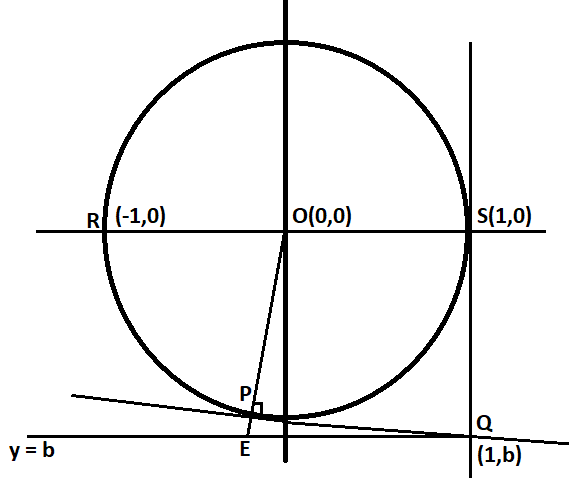Question
Question: Let RS be the diameter of the circle \({x^2} + {y^2} = 1\), where S is the point \((1,0)\). Let P be...
Let RS be the diameter of the circle x2+y2=1, where S is the point (1,0). Let P be a variable point (other than R and S) on the circle and tangents to the circle at S and P meet at the point Q. The normal to the circle at P intersects a line drawn through Q parallel to RS at point E. Then the locus of E passes through the point(s)
A. (31,31)
B. (41,21)
C. (31,3−1)
D. (41,2−1)
Solution
First of all this a simple problem, though it may seem to be complex. In order to solve the problem, we need to have some knowledge regarding a few topics about circles. Such as the basic general equation form of a circle, tangent equation of a circle. When given the equation of a circle, we should be able to recognize the coordinates of the center and the radius of the circle.
Complete answer:
The general equation form of a circle is given by x2+y2=r2, where the center of the circle is the origin and it has a radius of r units.
Visualizing the given information inform in a figure, as given below:
Given that the circle is of a radius of 1 unit, from x2+y2=1, from here it is clear that the radius of the circle is 1 unit.

Gathering from the given information, P is a point on the tangent of the circle.
The tangents drawn from these points S and P meet at Q, which is a point on the same vertical line as the point S, which means that the x-coordinate remains the same for the point Q, which is 1.
The x-coordinate for Q is 1, and let the y-coordinate be a variable b.
So the coordinates of the point are Q =(1,b)
A normal of the circle or the tangent passes through its center, hence here the normal to the circle through the point P, intersects a line drawn through Q parallel to RS at point E.
Now the line parallel to RS which is the line QE, as it passes through the point Q and parallel to RS, which means that Q and E are on the same horizontal line, which means that the points Q and E have the same y-coordinate which is b.
Let us consider the coordinates of the point P to be (cosθ,sinθ), as P is the point on the circle it should satisfy the circle equation which is x2+y2=1, so x-coordinate to be cosθand y-coordinate to be sinθsatisfies the equationx2+y2=1.
⇒cos2θ+sin2θ=1
Now as this normal line OP passes through the origin and the point P(cosθ,sinθ).
Hence the equation of any line which passes through the origin is given by y=mx
Here m is the slope of the line OP, which is given by the ratio of difference of y coordinates to the difference of x coordinates of O(0,0) and P(cosθ,sinθ), as given below:
⇒m=cosθ−0sinθ−0
⇒m=tanθ
Hence the equation of the line OP is given by:
⇒y=(tanθ)x
This line OP also passes through the point E, hence this point should satisfy the equation y=(tanθ)x.
We only the y-coordinate of the point E which is b, so by substituting the y-coordinate in the equationy=(tanθ)x, gives:
⇒b=(tanθ)x
⇒tanθb=x, is the x-coordinate of the point E
∴The coordinates of the point E are (tanθb,b).
We know that the tangent equation of the circle is given by:
⇒xx1+yy1=r2
Where r is the radius of the circle and (x1,y1)are the coordinates of the point on the circle and the tangent of the circle, which is P here, as given below:
⇒(x1,y1)=(cosθ,sinθ)
Hence the tangent equation becomes:
⇒xcosθ+ysinθ=1
This tangent meets the point Q (1,b), therefore this point should satisfy the tangent equation as given below:
⇒1(cosθ)+b(sinθ)=1
⇒cosθ+bsinθ=1
On expanding cosθ and sinθ, as given below:
⇒(1−2sin22θ)+b(2sin2θcos2θ)=1
⇒1−2sin22θ+2bsin2θcos2θ=1
As 1 gets cancelled on both sides, as given below:
⇒2sin22θ=2bsin2θcos2θ
The above expression is obtained after 2sin2θ gets cancelled on both sides.
⇒sin2θ=bcos2θ
⇒cos2θsin2θ=b
∴b=tan2θ
Now substituting the value of b in the point E(tanθb,b)
The x-coordinate of E is tanθb=tanθtan2θ,
The y-coordinate of E is b=tan2θ
Expanding the x-coordinate, as given below:
⇒tanθtan2θ=1−tan22θ2tan2θtan2θ
⇒tanθtan2θ=21(1−tan22θ)
∴x=21(1−tan22θ)
And y=tan2θ
Hence the locus of the point E is y2+2x=1
We can verify this by substitution as given below:
⇒y2+2x=(tan2θ)2+2(21(1−tan22θ))
⇒y2+2x=tan22θ+1−tan22θ
⇒y2+2x=1
∴y2+2x=1 is the locus of the point E.
Hence the locus of the point E passes only through (31,31) and (31,3−1)
Note:
There is one important thing which we have to understand is that we know that the general equation of a circle is given by x2+y2=1, where the circle center is (0,0) and the radius of the circle is 1 unit. Whereas if given the circle equation as (x−a)2+(y−b)2=r2, then the center of the circle is (a,b) and the radius of the circle is r units. Also the trigonometric formulas were used like cosθ=1−2sin22θ and sinθ=2sin2θcos2θ, which are very important to remember.
